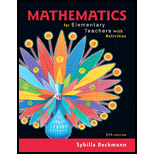Solutions for MyLab Math with Pearson eText -- Standalone Access Card -- for Mathematics for Elementary Teachers with Activities (5th Edition)
Browse All Chapters of This Textbook
Book Details
Empowering Tomorrow's Math Teachers
Mathematics for Future Elementary Teachers, 5th Edition connects the foundations of teaching elementary math and the "why" behind procedures, formulas and reasoning so students gain a deeper understanding to bring into their own classrooms. Through her text, Beckmann teaches mathematical principles while addressing the realities of being a teacher. With in-class collaboration and activities, she challenges students to be actively engaged. An inquiry-based approach to this course allows future teachers to learn through exploration and group work, leading to a deeper understanding of mathematics. Known for her contributions in math education, Sybilla Beckmann writes the leading text for the inquiry approach - in Mathematics for Elementary Teachers with Activities, students engage, explore, discuss, and ultimately reach a true understanding of mathematics. Beckmann's text covers the Common Core State Standards for Mathematics (CCSSM) now implemented in most states. However, states not following Common Core will not find the information intrusive in the text.
Sample Solutions for this Textbook
We offer sample solutions for MyLab Math with Pearson eText -- Standalone Access Card -- for Mathematics for Elementary Teachers with Activities (5th Edition) homework problems. See examples below:
More Editions of This Book
Corresponding editions of this textbook are also available below:
